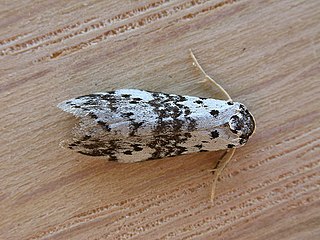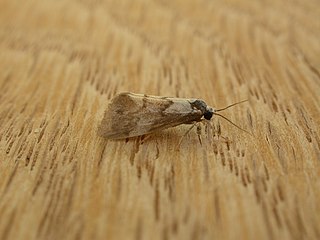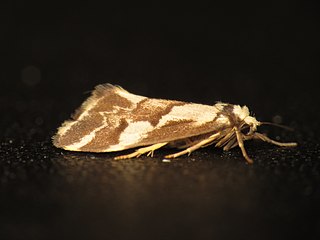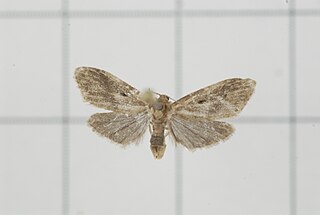Related Research Articles

Thallarcha is a genus of moths in the subfamily Arctiinae.

The Depressariinae – sometimes spelled "Depressiinae" in error – are a subfamily of moths in the superfamily Gelechioidea. Like their relatives therein, their exact relationships are not yet very well resolved. It has been considered part of family Elachistidae sensu lato or included in an expanded Oecophoridae. In modern classifications they are treated as the distinct gelechioid family Depressariidae.

Philenora malthaca is a moth of the subfamily Arctiinae first described by Alfred Jefferis Turner in 1944. It is known in Australia from the south-east coastal regions of New South Wales. There is a single record from Dromana in Victoria.

Xyloryctidae is a family of moths contained within the superfamily Gelechioidea described by Edward Meyrick in 1890. Most genera are found in the Indo-Australian region. While many of these moths are tiny, some members of the family grow to a wingspan of up to 66 mm, making them giants among the micromoths.
Exilisia bipuncta is a moth of the subfamily Arctiinae. It was described by George Hampson in 1900. It is found on Madagascar.
Philenora aroa is a moth in the subfamily Arctiinae. It was described by George Thomas Bethune-Baker in 1904. It is found in New Guinea.

Philenora aspectalella is a moth in the subfamily Arctiinae. It was described by Francis Walker in 1864. It is found in the Australian states of Queensland, New South Wales, Victoria and the southern part of Western Australia.
Philenora brunneata is a moth in the subfamily Arctiinae. It was described by Franz Daniel in 1965. It is found in Afghanistan.

Philenora chionastis is a moth in the subfamily Arctiinae. It was described by Edward Meyrick in 1886. It is found in the Australian states of Queensland and New South Wales.

Philenora latifasciata is a moth in the subfamily Arctiinae. It was described by Inoue and Kobayashi in 1963. It is found in Japan and Taiwan.
Philenora nudaridia is a moth in the subfamily Arctiinae. It was described by George Hampson in 1900. It is found in the Australian state of Queensland.
Philenora omophanes, the delicate philenora, is a moth in the subfamily Arctiinae. It was described by Edward Meyrick in 1886. It is found in the Australian states of New South Wales and Victoria.
Philenora placochrysa is a moth in the subfamily Arctiinae. It was described by Turner in 1899. It is found in Queensland, Australia.
Philenora pteridopola is a moth in the subfamily Arctiinae. It was described by Alfred Jefferis Turner in 1922. It is found in Australia.
Philenora tenuilinea is a moth in the subfamily Arctiinae. It was described by George Hampson in 1914. It is found in Taiwan.
Philenora undulosa is a moth in the subfamily Arctiinae. It was described by Francis Walker in 1857. It is found in Australia.
Philenora lunata is a moth in the subfamily Arctiinae. It was described by Thomas Pennington Lucas in 1890. It is found in Australia.
Philenora irregularis is a moth in the subfamily Arctiinae. It was described by Thomas Pennington Lucas in 1890. It is found in Australia.
Epicopeia philenora is a moth in the family Epicopeiidae. It was described by John O. Westwood in 1841. It is found in India.
References
- ↑ Savela, Markku (December 7, 2015). "Philenora cataplex Turner, 1940". Lepidoptera and Some Other Life Forms. Retrieved October 24, 2019.
- Pitkin, Brian & Jenkins, Paul. "Search results Family: Arctiidae". Butterflies and Moths of the World. Natural History Museum, London.